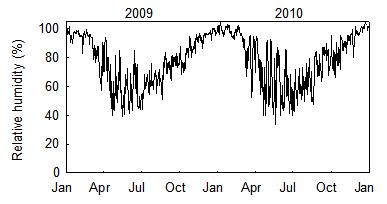The water holding capacity of air depends sharply on the air’s temperature (i.e. the warmer the air is, the more water it can hold). At a given temperature, air is saturated when it reaches the maximum water holding capacity that is also known as the dew point.
Relative humidity (RH) is the ratio between how much water vapour there is in the air and how much moisture the air can hold when it is saturated whereas vapour pressure deficit (VPD) is the difference between these two.
At Hyytiälä, the relative humidity of air ranges from 30 to 100%, with the most common daytime values around 50–70%. At night, the relative humidity increases as temperature decreases. Spring is the season with the driest air. The air gets increasingly moist along the growing season and towards the autumn. Relative humidity of 100% in general equals to rain or fog episodes. You can also study the changes in air humidity by viewing obervations made at Hyytiälä Forestry Field Station.
When the air becomes too dry, the pores at the surface of the leave will tend to close to reduce transpiration and to avoid losing too much water. The direct consequence is a decrease of the flow of CO2 into the crown and therefore also carbon assimilation.
Most of the diurnal changes in the air humidity are caused by the changes in temperature. If the day is cloudy with no significant increases in temperature occurring, the air moisture stays high.
Relative humidity will be lowest when the air is warmest during the day whereas it will be highest when the air is the coolest in the early morning. Meanwhile, VPD changes in opposite direction being highest during a day and smallest in night time. In winter, air moisture is mostly high outside.


Vapor pressure deficit (VPD) is the difference between the amount of water vapour in the air and how much water the air can hold when it is saturated. It takes into account the effect of temperature on the water holding capacity of the air, which roughly increases with temperature. Therefore, calculation of VPD is more interesting than relative humidity (RH) alone.
Vapor pressure is a measurement of how much water vapor is present in the air. More water vapor in the air means greater water vapor pressure. The maximum water vapor content in given temperature in the air is called the saturation vapor pressure (also known as dew point), which is directly related to temperature. The mathematical definition of VPD is the difference between the saturation vapor pressure and the actual air vapor pressure.
Higher VPD means the air is low and that the air has a higher capacity to hold water, stimulating transpiration i.e. increasing the transpirational demand and influencing how much moisture from plant tissues is transferred into the atmosphere. Lower VPD means high humidity i.e. the air is near saturation, so the air cannot include more moisture from leaves.